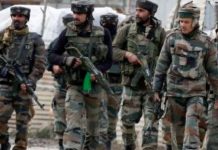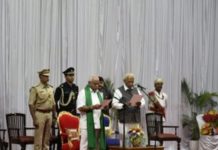
IT WAS rather trying to stay alive early morning on 10 February in the city of Allahabad in Uttar Pradesh, on the banks of what is arguably the world’s holiest river, the Ganga. Raging to jump in it all at once to score eternal salvation, an estimated 30 million Hindu faithful had massed near it, breathing life into the cliche of ‘a sea of humanity’. But a total collapse of ground management turned that sea terribly choppy. About 40 pilgrims lost their lives in two stampedes as the day wore on. First, a frenzied run by hundreds of thousands near the river’s holiest part, the sangam, where it meets the Yamuna river, snuffed out two lives. (Local newspapers said at least four had died.) Hours later, outbound devotees packing the city’s largest train station stampeded, killing 36 more. Their moment in history’s biggest ever gathering also turned out to be their last.
But tragic as the deaths were, they should hardly be surprising news. The inside story of the Maha Kumbh Mela — the two-month juggernaut held every dozen years as the pinnacle of the Hindu religious calendar — is a sordid tale of horrific unpreparedness caused by clashing egos, undermined authority, a lack of coordination between various agencies and institutionalised corruption. The most shocking, perhaps, is the claim of an official source that the administration knew its infrastructure was unfit to handle the tens of millions. “Privately, most of us thought no more than 20 million would turn up,” an official told TEHELKA, declining to be quoted. But the figure of 30 million the administration had spun for weeks turned out to be a self-fulfilling prophecy.
Essentially, the Ganga at Allahabad had 22 functioning bathing banks that day along a shoreline of about 5.5 km. Although everyone wants to take a dip at the sangam at the auspicious hour, authorities planned to bring devotees coming in from various directions to the different bathing banks. “We decided to tell the devotees that wherever they had reached was the sangam,” says an official. Hoping to thus trick the unsuspecting pilgrims, the authorities planned to turn them after the baths back towards where they came from. Over 7,000 buses were deployed at the various exits. The railway plotted outgoing journeys from six train stations. The millions were to disperse along the squid’s arms.
That fateful day, however, all traffic management plans failed as the unprecedented crowd of devotees, which began arriving the previous day, overwhelmed the constabulary and surged towards the sangam from all directions. When by the morning the crowd threatened to overrun the traditional first bathers — the yogis, babas and sadhus — the police panicked and started pushing the commoners out of the Mela ground, itself a smidgen of just 28 sq km. As is now known, the millions thus driven out began marching towards the biggest train station, the Allahabad Junction, which falls on the Delhi-Howrah railway route. Within hours, Allahabad city, itself densely populated with over a million inhabitants, was gridlocked.
“It took me 15 hours by car to reach my home 7 km from the Mela,” said businessman Anil Agrawal, who rents out a slew of Swiss cottages by the river to foreigners and well-heeled Indians. “It was the longest journey of my life for the shortest distance.” To slow down the crowds, the Mela authorities had rigged a maze of zigzag lanes, akin to those at airport checkins, in a ground the size of a football field. But the police failed to send the people into them just when it was needed. Deploying thousands of buses at exit points became counterproductive; once they were stranded in city traffic, the people riding them began fleeing on foot. A network of guides the government had stationed across the city in the previous Kumbh Mela of 2001 was conspicuously absent this time. Perplexingly, the decades old practice of making announcements on loudspeakers strung on bamboo and electric poles all over the city was absent, too. At the railway station, where the fatalities occurred, it took over two hours for medical assistance to reach, although the railway hospital is located just metres away. The Railway Police chief, who lives nearby, took longer to walk the distance.
What triggered such a colossal collapse of planning?
First, the lack of coordination. The management of the Kumbh Mela involves more than a dozen government agencies, functioning under the state and Central governments, playing critical roles. These include the police, sanitation, water supply, public works, electricity, healthcare, road transport and the railways. The Kumbh Mela is designated as a temporary administrative district of the state, with its own district magistrate and senior superintendent of police. The Uttar Pradesh government appointed a minister, Azam Khan, as the nodal minister for the event. Top guns such as the railway minister and Railway Board chairman visited over months. And yet, there is no single public official with whom the buck stops as it should. Moreover, no overall blueprint that incorporates the work of the various agencies was ever prepared.
A key reason for the chaos on 10 February was that coordination between the Mela authorities and the Allahabad district administration had long broken down . The two have run afoul of each other for months. Allahabad District Magistrate Raj Shekhar, an IAS officer, and Kumbh Mela administrator Mani Prasad Mishra, who started his career from the lower state-level PCS service, have barely interacted in months. Shekhar was not even invited to several planning meetings. Ironically, commentators judge both as fairly competent. But Chief Minister Akhilesh Yadav’s mandarins in Lucknow favoured neither. Instead, last year, they brought in Devesh Chaturvedi, a senior IAS officer with experience of the 2001 Kumbh Mela, as commissioner of Allahabad, making him the boss of both the Mela and the Allahabad districts.
HACKS COVERING the event have been astounded how Chaturvedi’s arrival relegated Mishra, who should be leading from the front as the designated Mela administrator, to the sidelines. When the state’s top bureaucrat, Chief Secretary Jawed Usmani, came down to inspect the Mela preparations in early January, it was Chaturvedi who accompanied him, while Mishra was tellingly absent. On the morning of 10 February, the commissioner and a handful of policemen were ineffectually trying to control the crowds at the sangam, while Mishra was nowhere to be seen.
Mela authorities grumble that Mishra was sidelined because Yadav’s predecessor, former CMMayawati, had appointed him over a year ago. The high court had earlier stipulated that a Mela chief once appointed cannot be removed without its approval. Ergo, he was pushed out of the loop, they say. Indeed, most tenders given during Mayawati’s tenure for construction and supplies were junked once Yadav came to power last March. Shivpal Yadav, the state’s public works minister, who is also the chief minister’s uncle and had famously told a gathering of bureaucrats last year that they should be only moderately corrupt, took his time to award fresh tenders.
With less than a month for the Mela to end, many basic facilities are not in place. Thousands of toilet seats are lying in a storehouse, while people defecate in the open. Ration shops are shut most of the day. Hardly anyone is able to buy the subsidised rice, pulses, flour and kerosene oil that should retail there. Of the 2 lakh ration cards that were to be issued to the poor before the Mela started, not even 80,000 were made until last week. Garbage has piled up across the landscape. At many places, the ground has turned into watery sludge, one such becoming the cause of deaths in 10 February’s first stampede.
ajit@tehelka.com












